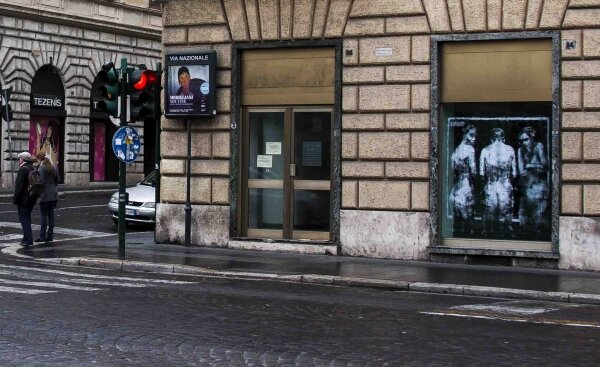Reflections on the Murals of Gonzalo Borondo
Since returning from Rome, where I reported for the Weaving the Streets and People’s History Archive (WSPHA) project this past spring, I find myself closing my eyes and allowing a wave of visual memories to wash over my mind. After living in such a visually captivating place there are an endless number of picture perfect moments to recall, but the images I am most enchanted by are ones that surprised me. Instead of reminiscing about the Pantheon saturated in afternoon sunlight, I think back to the images I felt most challenged or shocked by.
Every morning in Rome my bus to school would weave through chaotic traffic on the bustling shopping street Via Nazionale. A set of dark windows, which belonged to a foreclosed bank, served as a contrast to the otherwise bright and busy shops and restaurants. In one of the street facing windows I had noticed a drawing: a life-size depiction of three naked women huddling, clutching their bodies and looking out at the pedestrians on the sidewalk. The figures are white and ghostly, scratched into the windows with white paint. The first time I passed the window, I almost didn't notice the mural. Their presence was understated, slightly obscured and faded, but once I had noticed them it was impossible to look away. The naked, tortured look of the women's bodies seemed dramatically out of place amongst the commuters and tourists pushing past each other on the street.
This thought provoking painting is by the street artist Gonzalo Borondo, whose works can be found throughout Rome and Madrid. The Spanish artist paints onto glass and then scratches away an image, playing with ideas of light, shadow and transparency. Borondo lived in Rome while on an Erasmus cultural exchange program at the Accademia di Belle Arti di Roma and studied art at Madrid Complutense University. Growing up Borondo studied both classical art and graffiti, bringing influence from the Old Spanish masters into the streets. His worked gained recognition due to his innovative materials and manipulation of urban space. The artist, in an interview with the Culture Trip, writes, "I focus on the public space, I feel the environment, I am always looking at reality. It is there, outside, not here on the canvas or in the gallery, it is outside’. While working in a variety of mediums, he grew recognition for his glass scratching technique in empty store windows, a commentary on the economic recession demonstrating how site specificity in street art contributes to its overall message.
While the piece attempts to draw attention to economic change within a city, as I pass the murals on a daily basis they made me reflect on different social issues. The pieces are confrontational in a subtle way; their presence reminded me of the ease with which we can ignore the suffering of others in the chaos of our daily routine. I ended up finding his murals in other neighborhoods, some works so bleached that only the ghost of the mural remained, the figural skeletons adding to the complex layers of Rome's facades.

